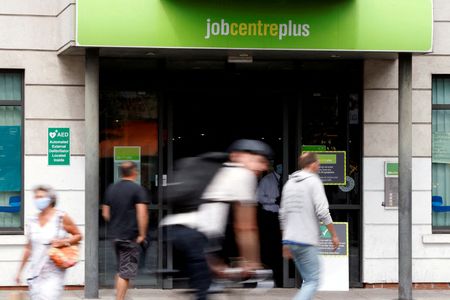
By David Milliken and William Schomberg
LONDON (Reuters) -Britain’s jobless rate hit a 48-year low in the first three months of 2022 and employers paid bigger bonuses to keep or attract staff, according to data that added to bets by investors on further Bank of England interest rate hikes.
Core earnings for most workers fell by the greatest amount since 2013 when adjusted for surging inflation, the Office for National Statistics said on Tuesday.
But total pay including bonuses was up 7.0% on a year earlier, far above economists’ average forecast of 5.4%.
Sterling climbed by 1.1% against the U.S. dollar and rose by 0.6% against the euro. Investors priced in a 30% chance that the BoE’s Monetary Policy Committee will resort to raising interest rates by half a percentage point in June.
The jobless rate dropped to 3.7% from 3.8% – below forecasts in a Reuters poll for it to hold steady – and the number of people out of work was less than job vacancies on offer for the first time on record.
“We were taken aback by the strength of today’s labour market release, especially bearing in mind the fears of a downturn in the economy,” Philip Shaw, an economist at Investec, said. “Indeed it will do nothing to quell the MPC’s concerns over inflationary pressures.”
The BoE fears that higher-than-normal pay growth could be a key channel through which the current energy-driven leap in inflation might become entrenched.
Consumer price inflation was 7.0% in March and official figures due on Wednesday are expected to show it hit 9.1% in April when a 54% rise in energy tariffs took effect.
The BoE expects further price rises will push the economy close to recession by the end of 2022, increasing unemployment.
But some economists said Tuesday’s data showed the central bank underestimated the labour market heat, at least for now.
“While the BoE’s message was dovish at the last meeting, the data continue to speak louder than MPC rhetoric and we remain confident that rates will rise again by 25 basis points in June,” economist Allan Monks at J.P. Morgan said.
STRONG PAY RISES, BUT ONLY FOR SOME
While Tuesday’s data showed soaring pay in some sectors – with total pay up a record 9.9% in March alone – the rewards from a tight labour market are unevenly distributed.
Bankers and builders are doing especially well, while public-sector workers face the biggest pay squeeze.
Regular pay rose only slightly more than expected, up 4.2%.
Adjusted for inflation, basic pay was 2.0% lower than a year ago, the biggest fall since the three months to September 2013.
Governor Andrew Bailey has said a fall in living standards is inevitable due to the energy price shock, and that a widespread push for higher pay would disproportionately benefit workers who were already in a strong position in the job market.
The uneven nature of wage gains should give the BoE pause for thought about raising interest rates, which financial markets expect to reach 2.0-2.25% by the end of the year, Pantheon Macroeconomics’s Samuel Tombs said.
“These numbers shouldn’t make the MPC panic about wage growth,” he said.
The labour market strength comes despite the economy stagnating in February and March.
The number of people in work rose by 83,000 in the first quarter of the year but is 444,000 below its level before the COVID-19 pandemic, largely reflecting increased long-term sickness and early retirement.
However, Tuesday’s data brought tentative signs this may be starting to reverse, with the largest number of people moving from ‘inactivity’ to work since these records began in 2001.
(Reporting by David MillikenEditing by William Schomberg and Raissa Kasolowsky)

